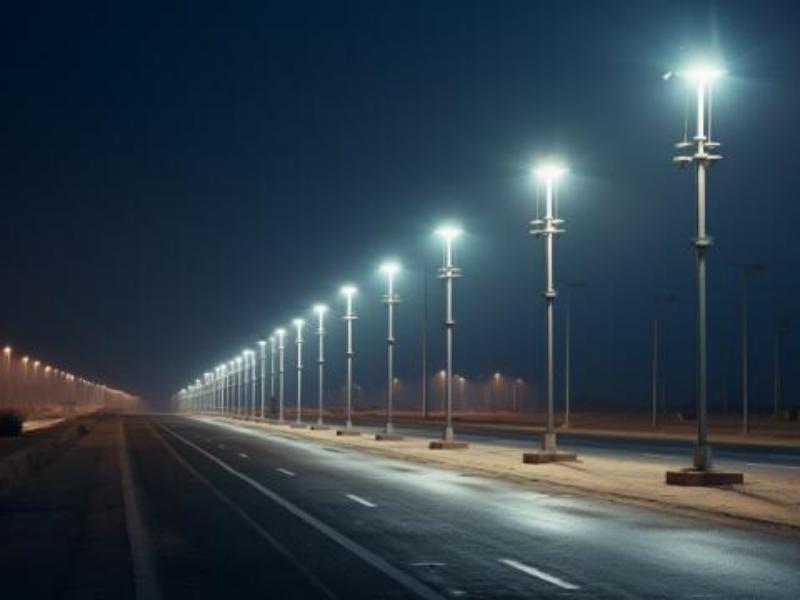Instal·laciófanals d'autopistaés una tasca molt important, que està directament relacionada amb la seguretat i l'eficiència del trànsit a l'autopista. Per tal de garantir la qualitat de la instal·lació dels fanals d'autopista i millorar la seguretat de la conducció nocturna, els següents són alguns avantatges de la instal·lació de fanals d'autopista i els requisits d'especificació per a la instal·lació de fanals d'autopista en projectes d'autopistes.
La instal·lació de fanals de carretera pot oferir diversos avantatges, com ara:
A. Visibilitat millorada:
Els fanals de carretera milloren la visibilitat dels conductors, especialment durant la nit i en condicions meteorològiques adverses, reduint la probabilitat d'accidents a causa de la mala visibilitat.
B. Seguretat millorada:
Unes carreteres correctament il·luminades poden reduir el risc de col·lisions, millorar els temps de reacció i augmentar la seguretat general dels conductors i els vianants.
C. Reducció de la delinqüència:
Les carreteres ben il·luminades poden dissuadir activitats delictives com el vandalisme, el robatori i altres comportaments il·legals, contribuint a un entorn més segur per als viatgers.
D. Augment del flux de trànsit:
Una millor visibilitat i una major seguretat poden conduir a un flux de trànsit més fluid i a una reducció de la congestió, especialment durant les hores nocturnes.
E. Suport a l'activitat econòmica:
Les autopistes ben il·luminades poden afavorir el desenvolupament econòmic permetent un transport de mercaderies i persones més segur i eficient, promovent el creixement econòmic a les regions afectades.
F. Millor navegació:
Els fanals d'autopista poden ajudar els conductors a navegar per sistemes carreteres complexos, sortides i interseccions, reduint la probabilitat de confusió i de perdre girs.
En general, la instal·lació de fanals d'autopista pot millorar significativament la seguretat viària, reduir els accidents i contribuir a un sistema de transport més segur i eficient.
Quan instal·leu fanals d'autopista, hi ha diversos factors a tenir en compte per a la seguretat i l'eficàcia. Aquí teniu algunes coses a les quals cal parar atenció:
A. Posicionament:
Assegureu-vos que els fanals estiguin col·locats de manera que proporcionin una il·luminació adequada de la carretera sense causar enlluernaments ni ombres.
B. Alçada:
Instal·leu els llums a una alçada adequada per aconseguir la cobertura d'il·luminació desitjada i evitar interferències amb els vehicles que hi passen.
C. Espaiat:
Espaieu adequadament els fanals per garantir una il·luminació uniforme i consistent al llarg de l'autopista sense buits ni solapaments.
D. Font d'alimentació:
Assegureu-vos que les làmpades estiguin connectades correctament a una font d'alimentació fiable per garantir un funcionament consistent.
E. Qualitat dels materials:
Utilitzeu materials duradors i d'alta qualitat per als fanals i els accessoris per suportar l'exposició a les inclemències del temps i els possibles impactes.
F. Compliment de la normativa:
Assegureu-vos que la instal·lació compleixi amb les normatives i els estàndards locals per a l'enllumenat de les carreteres per tal de promoure la seguretat i minimitzar els possibles riscos.
G. Accés per a manteniment:
Considereu la facilitat d'accés per al manteniment i la reparació dels fanals per tal de minimitzar les molèsties al trànsit de la carretera.
Si presteu atenció a aquests factors, podeu ajudar a garantir una instal·lació eficaç i segura dels fanals d'autopista.
En resum, els requisits legals per a la instal·lació de fanals de carretera en projectes d'autopistes inclouen prestar atenció a la ubicació, l'alçada, l'espaiat, la font d'alimentació, la qualitat del material, el compliment de les normatives, l'accés per al manteniment, etc. Les normatives exigeixen instal·lar els fanals de carretera en estricta conformitat amb les normatives per garantir la seguretat i el trànsit durant la conducció nocturna. L'eficiència és un bon servei prestat al públic i proporciona una bona garantia per a la construcció i l'ús de projectes de carreteres.
Si esteu interessats en la il·luminació de carreteres, no dubteu a contactar amb TIANXIANG.obtenir un pressupost.
Data de publicació: 04-01-2024

